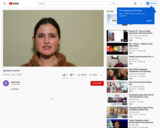
CC BY-NC
- Subject:
- Arts and Humanities
- Languages
- Material Type:
- Lecture
- Author:
- Sofia Duffy
- Date Added:
- 12/11/2020

CC BY-NC
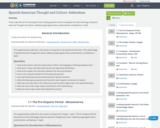
These materials are for teaching the class Creating Spanish America alongside the book Anthology of Spanish American Thought and Culture, edited by Jorge Aguilar Mora, Josefa Salmón, and Barbara C. Ewell.

A third-year intermediate course designed to improve speaking and writing, with opportunities for vocabulary acquisition, listening comprehension and reading practice as well. Uses literary and cultural readings, films, and group activities. Students give oral reports and participate in discussions and group projects.

Watch the video clips, waiting for a bus in Spain, and answer the questions using complete Spanish sentences.Photo: CC-BY-NC-ND deming131

This OER Spanish Describing People Authentic Resource (for Review) was created by Deborah Buchholz and as part of the 2024 World Language OER Summer work and training. Educators worked with Chrystal Liu, Nick Ziegler and Dorann Avey to create OER Learning Plans and materials. The attached ACTIVITY is designed for 9 - 12 World Language Arts teachers for Novice Learners of Spanish. Students will review vocabulary to describe people, watch a video of native Spanish speakers describing themselves, and identify the words that they hear. They will reflect on connections between words in Spanish and English. This Lesson Plan addresses the following NDE World Language Standard(s): NE WL 1.2.c, NE WL 1.2.d, NE WL 5.1.cIt is expected that this Activity will take students 30 minutes to complete.

This OER ACTIVITY was created by Deborah Buchholz and as part of the 2024 World Language OER Summer work and training. Educators worked with Chrystal Liu, Nick Ziegler and Dorann Avey to create OER Learning Plans and materials. The attached Lesson Plan is designed for 9 - 12 World Language Arts teachers for Novice Learners of Spanish. Students will read a short reading in Spanish and answer comprehension questions. This Lesson Plan addresses the following NDE World Language Standard(s): NE WL 1.1.c, NE WL 1.2c

4-6 weeks of distance (remote) learning content provided for middle through high school-level Spanish programs. These units were adapted from existing Unit & Pacing guides created by teachers from Tacoma Public Schools in Washington State.

Spanish I is very different from other classes at MIT. The central component of the text and workbook is a series of 26 half-hour video episodes. The videos allow students to learn authentic Spanish and experience its cultural diversity while following a good story full of surprises and human emotions. Students also listen to an audio-only program integrated with the text and workbook.
In the classroom, students do a variety of activities and exercises, which include talking in Spanish about the video program, practicing pronunciation and grammar, and interacting in Spanish with classmates in pairs and small groups. The class is conducted in Spanish as much as possible, but English is used where necessary for clarity and efficiency. This course deals with all basic language skills: aural comprehension, speaking, reading, and writing. This class assumes no previous knowledge of Spanish.
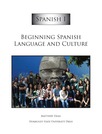
This peer-reviewed textbook is designed for the true beginner with U.S. college students in mind. It contains themed chapters, which are divided into 8 sections. Each section has its own set of learning objectives, and is further separated into three types of assignments, Para estudiar en casa (with detailed explanations), Para practicar en casa (homework exercises), and Para practicar en clase (paired and group classwork activities). The explanations and primary input are written to be easily comprehensible. The individual exercises are geared towards acquisition of form and function, and the communicative classwork exercises promote interpersonal exchanges between students. The digital copy includes some embedded audio files, and we are developing a website to house many more resources.

This course is an introduction to Spanish at a low-intermediate level.

Spanish II continues to develop students’ listening, speaking, reading and writing skills using the second part of the video-based program, Destinos, begun in Spanish I. Destinos is a soap opera that allows students to learn Spanish and experience its cultural diversity while following a good story full of surprises and human emotions. Spanish II also includes additional materials, such as Spanish films and other media, various types of reading selections and online resources.

This course is the first intermediate-level course in Spanish, with a focus on grammar review, additional vocabulary, writing of essays in Spanish and enhancement of cultural awareness. Group activities and projects, and conversation are emphasized. There are detailed simulation activities, readings about literature and art from Latin America and Spain, activities with music videos and interviews, and viewings of recent films such as El espinazo del diablo, Juana la loca, and María llena eres de gracia. Students also participate in the MITUPV Exchange project, a multimedia-centered Web site that deals with university life at MIT, the Universidad Politécnica de Valencia in Spain, and other universities.

This resource was designed for a Spanish student who has taken at least one semester of college-level Spanish, one year of High-School Spanish or has some basic knowledge of Spanish. Its content can be useful (and adapted to) more advanced students, even heritage speakers who would like to improve their speaking, listening, reading and writing skills as well as explore Spanish, Latin and Hispanic Culture.This online resource can be used as a textbook for an entire one-semester college course. It is comprised entirely of free, open-educational resources which are available to anyone. These include SpanishDict.com, StudySpanish.com, The Spanish Experiment, YouTube and much more.The content is practical, authentic and engaging, but more importantly, it allows students to acquire much more than basic Spanish skills. It provides students with oppotunities to learn about Spanish, Latin and Hispanic culture and geography, as well as acquainting the students with Spanish as it is actually spoken in many different countries.The textbook is divided into 15 modules with each module centering around specific themes and grammatical structures. Even though grammar is essential to learning any language, in this course speaking the language, strategies for learning languages and culture are just as (or even more) important than extensive grammar drills.

This resource was designed for a Spanish student who has taken at least one semester of college-level Spanish, one year of High-School Spanish or has some basic knowledge of Spanish. Its content can be useful (and adapted to) more advanced students, even heritage speakers who would like to improve their speaking, listening, reading and writing skills as well as explore Spanish, Latin and Hispanic Culture.This online resource can be used as a textbook for an entire one-semester college course. It is comprised entirely of free, open-educational resources which are available to anyone. These include SpanishDict.com, StudySpanish.com, The Spanish Experiment, YouTube and much more.The content is practical, authentic and engaging, but more importantly, it allows students to acquire much more than basic Spanish skills. It provides students with oppotunities to learn about Spanish, Latin and Hispanic culture and geography, as well as acquainting the students with Spanish as it is actually spoken in many different countries.The textbook is divided into 15 modules with each module centering around specific themes and grammatical structures. Even though grammar is essential to learning any language, in this course speaking the language, strategies for learning languages and culture are just as (or even more) important than extensive grammar drills.

This resource was designed for a beginning Spanish student, but its content can be useful (and adapted to) more advanced students.This online textbook is comprised entirely of free, open-educational resources which are available to anyone. These include SpanishDict.com, StudySpanish.com, The Spanish Experiment, YouTube and much more.The content is practical, authentic and engaging, but more importantly, it allows students to acquire much more than basic Spanish skills. It provides students with oppotunities to learn about Spanish, Latin and Hispanic culture and geography, as well as acquainting the students with Spanish as it is actually spoken in many different countries.The course is divided into 15 modules with each module centering around specific themes and grammatical structures. Even though grammar is essential to learning any language, in this course speaking the language, strategies for learning languages and culture are just as (or even more) important than extensive grammar drills.

This resource was designed for a beginning Spanish student, but its content can be useful (and adapted to) more advanced students.This online textbook is comprised entirely of free, open-educational resources which are available to anyone. These include SpanishDict.com, StudySpanish.com, The Spanish Experiment, YouTube and much more.The content is practical, authentic and engaging, but more importantly, it allows students to acquire much more than basic Spanish skills. It provides students with oppotunities to learn about Spanish, Latin and Hispanic culture and geography, as well as acquainting the students with Spanish as it is actually spoken in many different countries.The course is divided into 15 modules with each module centering around specific themes and grammatical structures. Even though grammar is essential to learning any language, in this course speaking the language, strategies for learning languages and culture are just as (or even more) important than extensive grammar drills.

Course Sequences
Spanish IV aims at developing and improving student’s oral and written communication through the continued study of the language, literature and culture of Spain, Latin America and Hispanic communities in the United States. It also seeks to improve students’ ability to read and appreciate literary and non-literary texts in Spanish, deepening this way students’ awareness and understanding of the cultural diversity of the Spanish-speaking world. The course is organized by themes based on contemporary social, political and cultural issues of Spanish-speaking societies such as: cultural identity, the changing roles of women and family, economic development and its effects on cultural heritage and environment, and the individual’s rights in the political system.
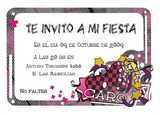
This OER Spanish Invitation was created by Danielle Fulcher and as part of the 2024 World Language OER Summer work and training. Educators worked with Chrystal Liu, Nick Ziegler and Dorann Avey to create OER Learning Plans and materials. The attached Lesson Plan is designed for 9 - 12 World Language Arts teachers for student learning of Mid Novice Learners of Spanish. Students will write their own invitation to an event. After writing their invitations, they will do an interpersonal activity in which they extend invitations to their classmates. This activity addresses the following NDE World Language Standard(s): NE LA 12.1.6b, NE LA 12.1.6l, and NE LA 12.1.6oIt is expected that this activity will take students 90 minutes to complete.
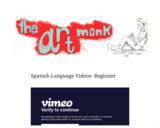
Short videos with illustrations, utilizing beginning Spanish vocabulary. Giving students visuals to associate with the vocab words learned during instruction.
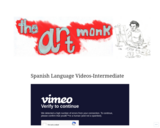
Animated shorts without subtitles or captions, utilizing intermediate level Spanish vocabulary.